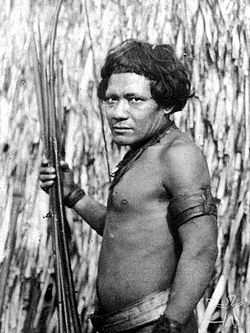Parintintín
|
Parintintin man, ca. 1920s | |
| Total population | |
|---|---|
| 418 (2010)[1] | |
| Regions with significant populations | |
|
| |
| Languages | |
| Parintintin, Portuguese[2] | |
| Related ethnic groups | |
| Tenharim, Diahhoi[2] |
The Parintintin are an indigenous people that live in Brazil in the Madeira River basin. They refer to themselves as Cabahyba, Kagwahiva’nga, or Kagwahiva, which means "our people."
As of 2010, the Parintintin have a population of around 418[1] and live in three villages on two indigenous territories (TIs):
- TI Ipixuna 215,362 hectares (2,154 km2; 832 sq mi), and
- TI Nove de Janeiro 228,777 hectares (2,288 km2; 883 sq mi).[3]
Language and culture
The Parintintin language is a dialect of the Tenharim language, which belongs to the Tupi-Guarani language family. It is written in the Latin script.[2]
Parintintin people are argicultalists, fishermen, and gatherers.[2] Their social structure is based on two moieties that are exogamous and named for different types of birds. They are a patrilineal society.[1]
History
Following contact with Brazilians in 1946, a population of 4,000 at the time was eventually reduced to 120 after Brazil's second rubber boom and the construction of the Trans-Amazon highway in 1970. Further colonization of the Amazon basin led to the spread of diseases that the Parintintin were not prepared for.[4]
Current issues
The Parintintin currently face possible downstream impacts from the Madeira Hydroelectric Complex.
See also
- List of indigenous peoples in Brazil
Notes
- ↑ 1.0 1.1 1.2 "Parintintin: Introduction." Povos Indígenas no Brasil. Retrieved 8 Feb 2012.
- ↑ 2.0 2.1 2.2 2.3 "Ticuna." Ethnologue. Retrieved 1 Feb 2012.
- ↑ Instituto Socioambiental
- ↑ Hurwitz, Z. (2008), "The Price of Profits." Cultural Survival Quarterly (32)1:2008.
External links
- Instituto Socioambiental (Portuguese)
- Parintintin (Portuguese)
- Flickr set of TI Nove de Janeiro
- International Rivers
